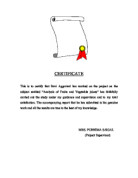AQA As Applied Science Unit 3. Colorimetry experiment on Ribena juices
Colorimetry
Aim:
- The aim behind this science is to measure colours and to predominantly quantify the colour of light sources or objects from visual colour matches. (This means that the eye(s) are used as a tool to identify if the colour is identical or not.
Scenario: I am a scientist, my first task is to go into a laboratory and test the concentrations of different Ribena juices, then I am going to find out the unknown dilutions for both Tesco and Asda Ribenas.
Hypothesis:
The more expensive the higher quality it will be therefore the stronger the concentration of the drink. The cheaper the Ribena juice the lower quality it will be therefore a weaker concentration of the drink.
Scientific Background:
A specific solution will be used to measure and determine the absorbance of particular wavelengths of light by a specific solution.
This is the procedure is used to measure the amount of light something absorbs, this is then measured in units of absorbance, this is also directly proportional to its concentration, this method is used to determine concentration. Colorimetry is also the technology and science used to quantify and describe the human colour perception.
What is colorimetry used for?
Colorimetry is used in most industries such as:
- Food
- Paint manufacturing
- Colour printing
- Textile manufacturing
- Chemistry
ASDA
Equipment:
- Ribena
- Distilled water
- Curette
- Graduated flask
- Graph paper
- Pipette
- Colorimetric
- Glass Beakers
- Pipette filler
Method:
- Set up all the Colorimetry equipment
- Get a Pipette filler and a Pipette and measure 20ml of the Ribena
- Put 20ml in to a graduated flask
- Put water in until it reaches the mark
- Measure the Ribena juice and the distilled water
- Put a sample of pure distilled water in to the curette and set to zero
- Pour the Ribena juice and distilled water in to the Graduated flask
- Close the top of the volumetric flask and shake them together so that the Ribena juice and distilled water mix
- Put a small amount of the solution gathered in to a curette
- Record the absorbance, this is done by a number which shows up on the curette
- Repeat these steps depending on the amount of Ribena
- At the end plot a calibration graph with all the concentrations and percentages
Results:








